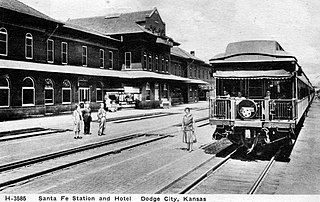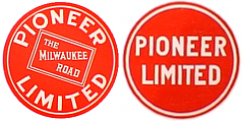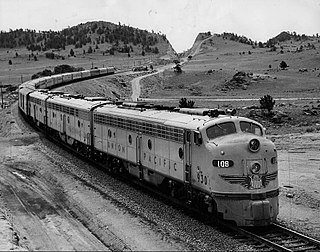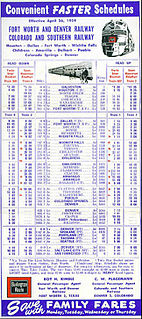
The City of Portland was a named passenger train operated by the Union Pacific Railroad between Chicago, Illinois, and Portland, Oregon. It started service in June 1935, using the streamlined M-10001 trainset. With only one set of equipment the train left each of its terminals five times a month. The route used Chicago and Northwestern trackage between Chicago and Omaha, Nebraska until 1955, replaced by Milwaukee Road trackage.

The Super Chief was one of the named passenger trains and the flagship of the Atchison, Topeka and Santa Fe Railway. The streamliner claimed to be "The Train of the Stars" because of the various celebrities it carried between Chicago, Illinois, and Los Angeles, California.

The City of Denver was a streamlined passenger train operated by the Union Pacific Railroad between Chicago, Illinois, and Denver, Colorado. It operated between 1936 and 1971. From 1936–1955 the Chicago and North Western Railway handled the train east of Omaha, Nebraska; the Chicago, Milwaukee, St. Paul and Pacific Railroad handled it thereafter. The train was the fastest long-distance train in the United States when it debuted in 1936, covering 1,048 miles (1,687 km) in 16 hours. For almost its entire career its principal competitor was the Chicago, Burlington and Quincy Railroad's Denver Zephyr. When Amtrak assumed operation of most intercity trains in the United States in 1971, it discontinued the City of Denver, preferring to use the Burlington's route between Chicago and Denver.

A dome car is a type of railway passenger car that has a glass dome on the top of the car where passengers can ride and see in all directions around the train. It also can include features of a coach, lounge car, dining car, sleeping car or observation. Beginning in 1945, dome cars were primarily used in the United States and Canada, though a small number were constructed in Europe for Trans Europ Express service, and similar panorama cars are in service on Alpine tourist railways like the Bernina Express.

The North Coast Limited was a named passenger train operated by the Northern Pacific Railway between Chicago and Seattle via Bismarck, North Dakota. It started on April 29, 1900, and continued as a Burlington Northern Railroad train after the merger on March 2, 1970 with Great Northern Railway and the Chicago, Burlington and Quincy Railroad. The next year, it ceased operations after the trains which left their originating stations on April 30, 1971, the day before Amtrak began service, arrived at their destinations.

The Chief was one of the named passenger trains of the Atchison, Topeka and Santa Fe Railway. Its route ran from Chicago, Illinois to Los Angeles, California. From 1948 to 1967 the Chief provided a connection at Chicago to LA for Pennsylvania Railroad overnight 16-hour New York and Philadelphia to Chicago, all-Pullman sleepers Broadway Limited and the New York Central20th Century Limited / New England States from NY/Boston. The Chief left Chicago at 1.30pm from 1948 and at 10am from 1954 on an accelerated 37hr service with connecting sleepers from the 2Oth Limited and Broadway Limited for Los Angeles and also Kansas City, Denver and Phoenix. Reaching Los Angeles before midnight the following day, the Chief was the only US train offering one night transit Chicago-Los Angeles westbound from 1954 and two night, transcontinental travel from NY to Los Angeles. The Chief was inaugurated as an all-Pullman limited train to supplement the road's California Limited, with a surcharge of USD $10.00 for an end-to-end trip. The heavyweight began its first run from both ends of the line, simultaneously, on November 14, 1926, scheduled 63 hours each way between Chicago and Los Angeles, five hours faster than the California Limited.

The Denver Zephyr was a streamlined passenger train operated by the Chicago, Burlington and Quincy Railroad between Chicago, Illinois, and Denver, Colorado. In peak years it ran to Colorado Springs. It operated from 1936 to 1973. The Denver Zephyr continued operating after the Burlington Northern Railroad merger in 1970. BN conveyed the train to Amtrak in 1971; Amtrak merged it with the Denver-Oakland City of San Francisco to form the San Francisco Zephyr and dropped the "Denver" name in 1973.

The Capitol Limited was an American passenger train run by the Baltimore and Ohio Railroad, originally between New York City and Grand Central Station in Chicago, Illinois, via Union Station, Washington, D.C., Baltimore and Pittsburgh. For almost 48 years, it was the B&O's flagship passenger train, noted for personalized service and innovation. At the time of its discontinuation on May 1, 1971, when Amtrak took over most rail passenger service in the U.S., the Capitol Limited operated between Washington and Chicago.

The Olympian and its successor the Olympian Hiawatha were passenger trains operated by the Chicago, Milwaukee, St. Paul and Pacific Railroad between Chicago and the Pacific Northwest. The Olympian operated from 1911 to 1947 and was, along with its running mate the Columbian, the first all-steel train to operate in the Pacific Northwest. The streamlined Olympian Hiawatha operated from 1947 to 1961 and was one of several Milwaukee Road trains to carry the name "Hiawatha." The Olympian Hiawatha was designed by industrial designer Brooks Stevens and included the distinctive glassed-in "Skytop" observation-sleeping cars. It later featured full-length "Super Dome" cars.

The Pioneer Limited was a United States named passenger train running overnight on the Chicago, Milwaukee, St. Paul and Pacific Railroad between Chicago, Illinois, and Minneapolis/St. Paul, Minnesota. The westbound train was Milwaukee Road train No. 1 and the eastbound was No. 4.
The Columbian was a named passenger train operated by the Chicago, Milwaukee, St. Paul and Pacific Railroad between Chicago, Illinois, and Seattle/Tacoma, Washington. The westbound train was Milwaukee Road train #17, and the eastbound train was train #18. It was launched on Monday, May 29, 1911. The same day, the faster, limited-stop and more luxurious Olympian also launched. These were the first passenger trains to take advantage of the Milwaukee Road Pacific Extension, which had opened to freight in 1909.

The Challengers were named passenger trains on the Union Pacific Railroad and the Chicago and North Western Railway. The economy service ran between Chicago, Illinois, and the West Coast of the United States. The trains had full Pullman service and coach seating and were an attempt to draw Depression-Era riders back to the rails. Food service was advertised as "three meals for under a dollar a day."

The Rocky Mountain Rocket was a streamlined passenger train of the Chicago, Rock Island and Pacific Railroad. Rock Island's train numbers 7 and 8 ran between Chicago's LaSalle Street Station and Denver's Union Station and Colorado Springs, Colorado. The Rocky Mountain Rocket ran from 1939 to 1966; the train was discontinued prior to the creation of Amtrak in 1971.
The Sioux was a named passenger train of the Milwaukee Road that operated between Chicago, Madison, Wisconsin, and Rapid City, South Dakota, via Prairie du Chien, Wisconsin and northern Iowa. The train, #11, westbound, and #22, eastbound, operated coaches, dining cars and sleeping cars through most of its history.
The Arrow was a passenger train operated by the Chicago, Milwaukee, St. Paul and Pacific Railroad between Chicago, Illinois and Omaha, Nebraska. It operated from 1926 until 1967. The Arrow provided overnight service between the two cities and included through cars for other destinations in Iowa.

The Twin Star Rocket was a passenger train operated by the Chicago, Rock Island and Pacific Railroad. Introduced on January 14, 1945, it was the only new streamlined train permitted to enter service in World War II by the U.S. government. The new train became the second longest north–south train itinerary under the management of a single railroad in the United States with its northern terminal at the Milwaukee Road’s Minneapolis depot and southern terminal 1,363 miles (2,194 km) away at Houston, Texas. The name of the new streamlined train was derived from its terminal states—Texas being known as the Lone Star State and Minnesota as the North Star State.

The Twin Cities Hiawatha, often just Hiawatha, was a named passenger train operated by the Chicago, Milwaukee, St. Paul and Pacific Railroad, and traveled from Chicago to the Twin Cities. The original train takes its name from the epic poem The Song of Hiawatha by Henry Wadsworth Longfellow. There are a number of Hiawatha-themed names within the city of Minneapolis, the terminus of the original train. The first Hiawatha ran in 1935; in 1939 the Milwaukee Road introduced a second daily trip between Chicago and Minneapolis. The two trains were known as the Morning Hiawatha and Afternoon Hiawatha, or sometimes the AM Twin Cities Hiawatha and PM Twin Cities Hiawatha. The Milwaukee Road discontinued the Afternoon Hiawatha in 1970 while the Morning Hiawatha continued running until the formation of Amtrak in 1971.
The Lake Shore Limited was a passenger train service operated by the New York Central Railroad between New York City and Chicago, Illinois, from 1897 to 1956. Separate sections linked to Boston and St. Louis. The Lake Shore Limited was the New York Central's first luxury passenger train, and paved the way for its more famous cousin the 20th Century Limited. The 1897 name is now used by Amtrak's Lake Shore Limited, which follows much the same route.

Phoebe Snow was a named passenger train which was once operated by the Delaware, Lackawanna and Western Railroad (DL&W) and, after a brief hiatus, the Erie Lackawanna Railway (EL).

The Overland Limited was an American named passenger train which for much of its history was jointly operated by three railroads on the Overland Route between San Francisco and Chicago. The Southern Pacific Railroad handled the train west of Ogden, Utah, the Union Pacific Railroad between Ogden and Omaha, Nebraska/Council Bluffs, Iowa, and east of the Missouri River to Chicago it was operated by the Chicago and North Western Railway as well as, for a few years starting in 1905, by the Chicago, Milwaukee, St. Paul and Pacific Railroad.


















